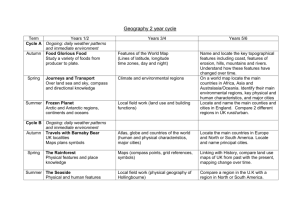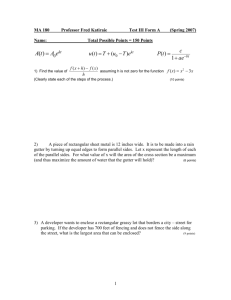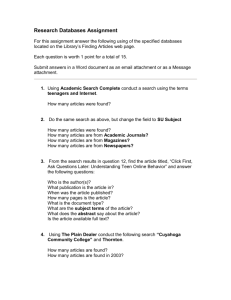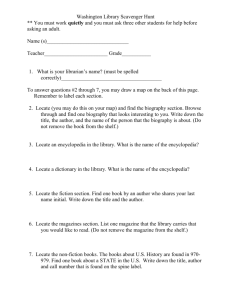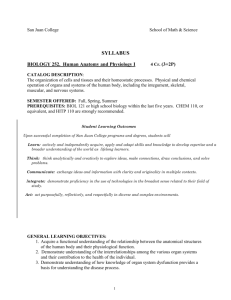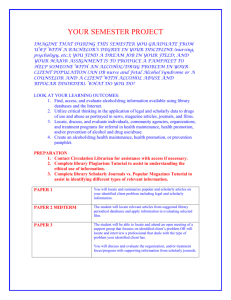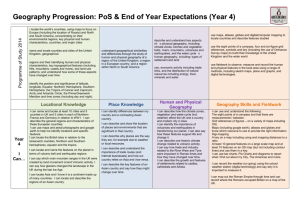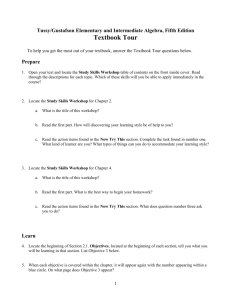Learning Objectives for Anatomy & Physiology Anatomy & Physiology
advertisement
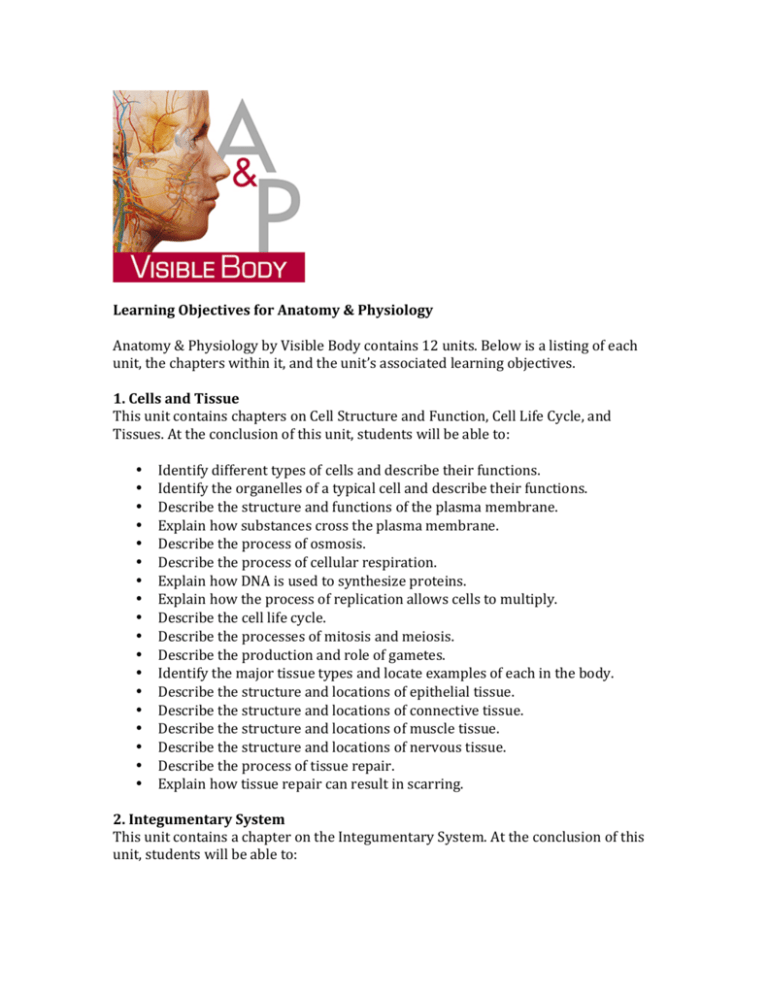
Learning Objectives for Anatomy & Physiology Anatomy & Physiology by Visible Body contains 12 units. Below is a listing of each unit, the chapters within it, and the unit’s associated learning objectives. 1. Cells and Tissue This unit contains chapters on Cell Structure and Function, Cell Life Cycle, and Tissues. At the conclusion of this unit, students will be able to: • Identify different types of cells and describe their functions. • Identify the organelles of a typical cell and describe their functions. • Describe the structure and functions of the plasma membrane. • Explain how substances cross the plasma membrane. • Describe the process of osmosis. • Describe the process of cellular respiration. • Explain how DNA is used to synthesize proteins. • Explain how the process of replication allows cells to multiply. • Describe the cell life cycle. • Describe the processes of mitosis and meiosis. • Describe the production and role of gametes. • Identify the major tissue types and locate examples of each in the body. • Describe the structure and locations of epithelial tissue. • Describe the structure and locations of connective tissue. • Describe the structure and locations of muscle tissue. • Describe the structure and locations of nervous tissue. • Describe the process of tissue repair. • Explain how tissue repair can result in scarring. 2. Integumentary System This unit contains a chapter on the Integumentary System. At the conclusion of this unit, students will be able to: • • • • • • • • • Identify the major components of the integumentary system and describe their functions. Identify the major structures of the skin and describe their functions. Identify the four types of epidermal cells and describe their functions. Describe the role of dermal circulation. Explain how vitamin D is synthesized. Describe the sensory innervation of the skin. Describe the structure, functions, and growth process of hair. Describe the structure and growth process of nails. Explain why the mammary glands are considered specialized integumentary glands. Describe the process of tissue repair and explain why scarring occurs. • 3. Skeletal System and Joints This unit contains chapters on Types of Bones, Bone Tissue, Axial Skeleton, Appendicular Skeleton, and Joints. At the conclusion of this unit, students will be able to: • Identify the major components of the skeletal system and describe their functions. • Describe the different types of bones and provide an example of each type. • Identify the parts of a long bone. • Identify the major types of bone cells and describe their functions. • Describe the structure and function of compact and spongy bone tissue. • Describe the role of calcium in the skeletal system. • Describe the processes of long and flat bone formation. • Describe the internal structure of a long bone. • Describe the components and functions of yellow and red bone marrow. • Describe the process of bone repair. • Identify the different types of fractures. • Describe how bone tissue changes with advancing age. • Locate and identify the structures that make up the axial skeleton. • Locate and identify the bones of the skull and major landmarks of the skull. • Describe the structure and function of skull sutures and fontanelles. • Locate and identify the auditory ossicles. • Describe the cross-­‐sectional structure of a vertebra. • Locate and identify bones, major bony landmarks, and ligaments of the vertebral column. • Locate and identify bones of the thoracic cage. • Locate and identify the structures that make up the appendicular skeleton. • Locate and identify the bones and major landmarks of the shoulder girdle. • Describe how some bones are stabilized by muscles. • Locate and identify the bones and major landmarks of the upper limb. • • • • • • • • • Describe the structure of the carpal tunnel and its role in carpal tunnel syndrome. Locate and identify the bones and major landmarks of the pelvic girdle. Describe the differences between the male pelvis and female pelvis, and explain why these differences exist. Describe the structure and function of the arches of the foot. Locate and identify the bones and major landmarks of the lower limb. Identify and describe the different types of joints, explain their functions, and provide an example of each type. Identify and describe the six major types of synovial joints, and provide an example of each type. Explain how ligaments reinforce joints and contribute to movement. Describe how joints can degenerate with advancing age. 4. Muscle Tissue and Muscular System This unit contains chapters on Skeletal Muscle Tissue, Smooth and Cardiac Muscle Tissue, and the Muscular System. At the conclusion of this unit, students will be able to: • Identify the three types of muscle and describe the muscular system’s functions. • Describe the location and function of skeletal muscles. • Locate and identify smooth muscle in the body. • Locate and identify the blood vessels and conduction system that supply and innervate cardiac muscle. • Describe the distinguishing features of each of the three types of muscle. • Locate and identify the major skeletal muscle regions of the body. • Describe the blood supply and innervation of skeletal muscles. • Describe the microscopic structure of skeletal muscle tissue. • Explain how an impulse generated by the central nervous system results in the contraction of a skeletal muscle. • Describe the location and function of smooth muscle. • Locate and identify smooth muscle layers of the stomach. • Describe the location and function of cardiac muscle. • Describe the roles of agonists and antagonists in muscle movement. Identify at least one example of paired muscles that oppose each other’s action. • Explain the meaning of the terms insertion and origin and describe how skeletal muscles attach to the bony skeleton. • Explain how the skeletal and muscular systems work together to produce leverage. Identify and describe examples of first, second, and third-­‐class levers in the body. • Locate, identify, and describe the functions of the following muscles or muscle groups or processes: o Facial expression o o o o o o o o o o o o o o o o o o o o o o o o o o o Extrinsic eye Mastication Tongue Suprahyoid Infrahyoid Vertebral column Abdomen Pelvis Diaphragm and intercostals Shoulder girdle Arm Rotator cuff Elbow flexors and extensors Forearm pronators and supinators Wrist/hand flexors and extensors Thenar, hypothenar, midpalmar Iliopsoas Gluteal Lateral rotators Anterior thigh Medial thigh Posterior thigh Anterior lower leg Lateral lower leg Posterior lower leg Foot, dorsum Foot, plantar layers 5. Nervous System and Special Senses This unit contains chapters on Nervous Tissue, Spinal Cord and Spinal Nerves, Brain, Cranial Nerves, Somatic and Autonomic Nervous Systems, and Special Senses. At the conclusion of this unit, students will be able to: • Identify the major components of the nervous system and describe their functions. • Describe the composition and location of nervous tissue. • Locate and identify the parts of a neuron. • Describe the structural types of neurons. • Describe the types of neuroglia and their functions. • Explain how resting and action potentials contribute to nerve function. • Describe the process of neurotransmission. • Identify major neurotransmitters and describe their functions. • Locate and identify the spinal cord and its meninges. • Locate and identify the cross-­‐sectional structures of the spinal column. • Describe the distribution and function of gray and white matter in the spinal cord. • • • • • • • • • • • • • • • • • • • • • • • • • • • • • • • • • • • • • • Explain how sensory signals and motor commands are relayed through the spinal cord and spinal nerves. Locate and identify the spinal nerves and nerve plexuses. Explain what a dermatome is and identify skin regions innervated by each spinal nerve. Locate and identify major spinal nerves and structures they innervate. Describe the somatic reflex arc. Locate and identify anatomical regions of the brain. Locate and identify anatomical structures that surround and protect the brain. Identify the ventricles of the brain and describe their function. Locate and identify blood vessels that supply the brain. Identify structures of the brain stem and describe their functions. Identify the parts of the cerebellum and describe their functions. Identify structures of the diencephalon and describe their functions. Identify structures of the limbic system and describe their functions. Identify structures of the cerebrum and describe their functions. Locate and identify the anatomical features of the cerebrum. Locate and identify functional regions of the cerebral cortex. Locate and identify the 12paired cranial nerves by name and number. Locate and identify the cranial nerves that transmit special sensory signals. Locate and identify the cranial nerves that transmit motor signals. Locate and identify the cranial nerves that transmit both sensory and motor signals. Describe the pathway and functions of each cranial nerve. Describe the functions of the somatic and autonomic nervous systems. Identify structures of somatic sensation and describe their functions. Describe the motor functions of the somatic nervous system. Describe the sensory and motor pathways of the somatic nervous system. Describe the roles of the basal ganglia and cerebellum in somatic nervous system function. Describe the functions of the somatic and autonomic nervous systems. Describe the structure of the autonomic nervous system. Describe the roles of the sympathetic and parasympathetic nervous systems. Locate and identify anatomical structures of the special senses. Describe the process of olfaction. Identify cranial nerves and describe the pathway of sensory impulses for each special sense. Describe the process of taste. Describe the process of vision. Explain how eye shape affects vision. Describe the role of the optic chiasm in binocular vision. Describe the process of hearing. Describe the process of equilibrium. 6. Endocrine System This unit contains chapters on Hormone Action and Regulation and Endocrine Organs and Functions. At the conclusion of this unit, students will be able to: • Identify the major components of the endocrine system and describe their functions. • Locate and identify the primary and secondary endocrine organs. • Describe the mechanisms of hormone action and the role hormones play in body functions. • Identify the hypothalamus and pituitary gland and describe their role in hormone production. • Identify hormones produced by the hypothalamus and describe their functions. • Identify hormones produced by the anterior lobe of the pituitary gland and describe their functions. • Identify hormones released by the posterior lobe of the pituitary gland and describe their functions. • Locate and identify target organs of pituitary hormones. • Locate and identify the thyroid gland. • Identify hormones produced by the thyroid gland and describe their functions. • Locate and identify the parathyroid glands. • Identify hormones produced by the parathyroid glands and describe their functions. • Locate and identify the adrenal glands. • Identify hormones produced by the adrenal glands and describe their functions. • Locate and identify the pineal gland, and describe its functions. • Locate and identify the pancreas. • Describe the location and function of pancreatic islets, and identify hormones they produce. • Describe how pancreas hormones blood glucose level. • Identify hormones produced by secondary endocrine organs and describe their functions. • Describe how hormones regulate the stress response. 7. Circulatory System This unit contains chapters on Blood, Heart, and Blood Vessels and Circulation. At the conclusion of this unit, students will be able to: • Identify the major components of the circulatory system and describe their functions. • Describe the exchange of gases between the lungs and bloodstream. • Identify the components of blood. • Describe the components and functions of plasma. • • • • • • • • • • • • • • • • • • • • • • • • • • • • • • • • • • Describe the production of red blood cells and their role in oxygen transport. Identify the different types of white blood cells and describe their functions. Explain how platelets contribute to the formation of blood clots. Describe the production of platelets. Describe the functions of the heart and the pericardium. Describe the heart’s location relative to the lungs, diaphragm, thoracic cage, and ribs. Identify the layers of the heart wall and describe each layer’s function. Locate and identify the four chambers of the heart. Describe the flow of blood through the heart and the role of each atrium, ventricle, and valve in this process. Locate and identify the four valves of the heart. Locate and identify the internal structures of the heart. Locate and identify the systemic and pulmonary vessels that enter and exit the heart. Locate the arteries and veins of coronary circulation and describe their function. Describe the function of the conduction system. Describe the steps of electrical conduction that lead to ventricular contraction. Locate and identify the major structures of the conduction system. Describe the purpose of an electrocardiogram. Describe the steps of the cardiac cycle. Describe systole and diastole and explain their place in cardiac cycle. Explain how cardiac output is determined. Locate and identify the autonomic nervous system structures that control and innervate the heart. Identify the five major types of blood vessels and describe their functions. Describe the structure and function of arteries, veins, arterioles, venules, and capillaries. Describe the structural differences between arteries and veins. Describe the relationship between blood pressure and resistance. Explain how arterial blood pressure is measured. Describe systolic and diastolic pressure. Identify the major routes of circulation and describe their functions. Locate and identify the vessels of pulmonary circulation. Explain how pulmonary veins and arteries differ from systemic veins and systemic arteries. Locate and identify structures of the lower respiratory system that contribute to gas exchange. Describe the functions of pulmonary arteries and pulmonary veins. Describe the flow of blood through systemic circulation. Locate and identify the great vessels of the circulatory system. Locate and identify arteries and veins of the: • • o head and neck o circle of Willis o upper limb o thorax o azygos system o hepatic portal system o abdomen o intestines o pelvis o leg and foot Locate and identify branches of the abdominal aorta. Locate and identify the venous sinuses. 8. Lymphatic System This unit contains chapters on Lymphatic System and Immunity. At the conclusion of this unit, students will be able to: • Identify the major components of the lymphatic system and describe their functions. • Describe the circulation of lymph throughout the body. • Locate and identify the major vessels of the lymphatic system. • Locate and identify lymphatic tissues and describe their functions. • Describe the internal structure of a lymph node. • Describe the body’s innate immune defenses. • Describe the process of phagocytosis. • Identify the different types of white blood cells, including lymphocytes. • Describe the body’s adaptive immune defenses. • Describe the functions of B cells and T cells. 9. Respiratory System This unit contains chapters on the Upper Respiratory System, Lower Respiratory System, and Respiration. At the conclusion of this unit, students will be able to: • Identify the major components of the respiratory system and describe their functions. • Describe pulmonary ventilation and identify the structures involved. • Describe external respiration and identify the structures involved. • Describe internal respiration and identify the structures involved. • Locate and identify structures of the nose and nasal cavity. • Locate and identify structures that make up the upper respiratory system. • Describe the functions of the nasal mucosa. • Describe the process and function of sneezing. • Describe the process of olfaction. • Locate and identify structures of the pharynx. • • • • • • • • • • • • • • • • • • • • • • • Describe the function of the epiglottis. Locate and identify structures of the larynx. Describe the process of phonation. Describe the relationship between vocal fold tension and sound pitch. Locate and identify structures that make up the lower respiratory system. Locate and identify the airways of the lower respiratory system. Describe the structure and function of the trachea. Describe bronchodilation and bronchoconstriction. Describe the location and shape of the lungs in relation to surrounding organs. Locate and identify each lobe and external feature of the lungs. Describe the location and structure of alveoli. Describe the location and functions of type I alveolar cells, type II alveolar cells, and alveolar macrophages. Describe the internal structures of the lungs. Locate and identify the vessels of pulmonary circulation. Explain how Boyle’s Law relates to breathing. Describe pulmonary ventilation and identify the structures involved. Locate and identify the muscles used during normal and forced inhalation. Locate and identify the muscles used during normal and forced exhalation. Explain how the respiratory and circulatory systems work together during external respiration. Describe external respiration and identify the structures involved. Using Dalton’s Law, explain why oxygen and carbon dioxide are exchanged between the lungs and the bloodstream. Describe internal respiration and identify the structures involved. Explain how imbalances of oxygen and carbon dioxide in the bloodstream affect respiratory rate. Locate and identify the nervous system structures that regulate respiration. • 10. Digestive System This unit contains chapters on Oral Cavity, Esophagus and Stomach, Accessory Organs of Digestion, and Small and Large Intestines. At the conclusion of this unit, students will be able to: • Identify the major components of the digestive system and describe their functions. • Describe the overall structure, sections and layers of the alimentary canal. • Describe the components and functions of major digestive juices, and explain where they are produced. • Explain how oral cavity structures contribute to the digestive process. • Locate and identify major structures of the oral cavity. • Describe the process of chewing and swallowing. • • • • • • • • • • • • • • • • • • • • • • • • • • • • • • Locate and identify the upper and lower arch of teeth. Identify the five types of teeth and describe each type’s function. Identify the parts of a tooth. Locate and identify the tongue and its extrinsic muscles. Explain how the tongue contributes to the sense of taste. Locate and identify the salivary glands and ducts. Locate and identify the muscles of mastication. Identify the epiglottis and describe its function during swallowing. Describe the process of peristalsis. Describe the location and pathway of the esophagus. Locate and identify the regions of the stomach. Identify the muscular layers of the stomach wall and explain how they differ from those of the rest of the alimentary canal. Locate and identify the sphincters through which food enters and exits the stomach. Locate and identify major blood vessels supplying and draining the stomach wall. Locate and identify the accessory digestive organs of the abdominal cavity. Locate and identify the lobes of the liver. Locate and identify the ligaments of the liver. Identify major veins of the hepatic portal system and describe the hepatic portal system’s function. Describe the role of the liver, gallbladder, and pancreas in producing, transporting, and storing digestive juices. Identify the bile ducts and describe their function. Identify the pancreatic ducts and duodenal papillae and describe their function. Locate and identify the major arteries supplying the liver, gallbladder, and pancreas. Describe the process of absorption that occurs in the small intestine. Describe the function of circular folds and villi in the small intestine. Locate and identify the regions of the small intestine. Describe the digestive processes that occur in the large intestine, including the role of bacteria. Locate and identify the major structures of the large intestine. Locate and identify the regions of the colon. Describe the function of the taenia coli. Locate and identify the major blood vessels that supply and drain the intestines. Explain how the defecation reflex occurs. • 11. Urinary System This unit contains chapters on Kidney Anatomy and Physiology, Urine Production, and Urine Storage and Information. At the conclusion of this unit, students will be able to: • Identify the major components of the urinary system and describe their functions. • Describe the anatomical differences between the male and female urinary systems. • Describe the position of the kidneys relative to other anatomical structures. • Locate and identify structures of the kidneys and describe their functions. • Locate and identify blood vessels that supply the kidneys. • Describe the path of blood flow through the nephron. • Describe the location, structure, and function of a nephron. • Describe the process of glomerular filtration. • Locate and identify structures involved in glomerular filtration. • Explain how the filtration membrane filters blood plasma to create filtrate. • Describe the processes of reabsorption and secretion, and explain why they are important. • Describe the composition of normal urine. • Explain how urine concentration is hormonally regulated. • Locate and identify the structures involved in urine storage and elimination, and trace the pathway of urine from the kidneys out of the body. • Describe the position of the bladder relative to other structures in the male and female. • Describe the internal anatomy of the bladder. • Describe the process of micturition. • Explain how micturition is controlled by the nervous system. • Locate and identify urinary system structures involved in maintaining urinary continence. • Describe the anatomical differences between the male and female urethra. 12. Reproductive System This unit contains chapters on the Male Reproductive System, Female Reproductive System, and Sexual Reproduction and Development. At the conclusion of this unit, students will be able to: • Identify the major components of the male and female reproductive systems and describe their functions. • Locate and identify the structures that make up the male reproductive system. • Describe the role of each male reproductive structure in producing, storing, and transporting semen. • Describe blood supply and innervation of the testes. • Describe the process of spermatogenesis. • • • • • • • • • • • • • • • • • • • • Locate and identify the regions of the male urethra. Describe the composition and functions of semen. Describe the physiological changes that occur during erection and ejaculation. Identify the hormones involved in male reproductive functions. Locate and identify the structures that make up the female reproductive system. Identify the hormones involved in female reproductive functions. Describe the process of oogenesis. Locate and identify blood vessels that supply the uterus and ovaries. Describe the phases of the female reproductive cycle. Describe the role of each female reproductive structure in sexual reproduction. Locate and identify structures involved in lactation. Describe the process of lactation. Describe the development of reproductive anatomy in utero. Explain how the reproductive system changes over the course of life. Describe the events that occur during fertilization and the role of each gamete in the process. Describe the earliest stages of zygote development after fertilization and where these stages occur. Describe the primary hormones that come into play during pregnancy. Explain how fraternal and identical twins occur. Describe the stages of fetal development during pregnancy. Describe the process of birth.
